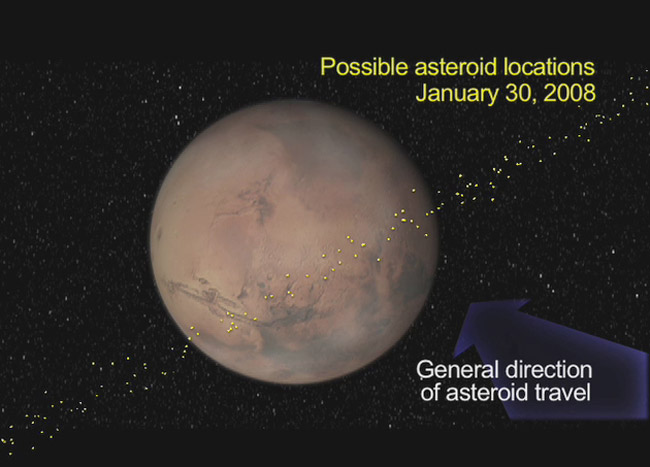Asteroid's Chances of Smacking Mars Dip

This story was updated at 11:04 p.m. EST.
The chancesof an asteroid smacking into Mars this month are slipping away as astronomers continueto refine its course toward the red planet.
The spacerock, an asteroidcalled 2007 WD5, is now expected to miss Mars by about 18,641 miles (30,000km), according a Tuesday report by NASA's Near Earth-Object (NEO) program office.
Scientistsnow estimate the space rock's odds of walloping Mars on Jan. 30 at 2.5 percent,about a 1-in-40 chance, after a series of observations taken by astronomersusing Spain's 11.5-foot (3.5-meter) Calar Alto Observatory. The new analysislowered the asteroid's odds of a martian impact from a 3.6 percent chance releasedlast week.
"Ifthe estimated miss distance remains stable in future updates, the impactprobability will continue to fall as continuing observations further constrainthe uncertainties," said the report, which was compiled by researchers atNASA's Jet Propulsion Laboratory (JPL) in Pasadena, Calif.
Astronomersat the University of Arizona firstglimpsed Asteroid 2007 WD5 last month while performing the Catalina SkySurvey. At the time, the space rock was hurtling through space at about 8 milesper second, which is about 28,800 miles per hour (46,349 kph) and15 times faster than a rifle bullet, researchers said.
With anestimated diameter of about 164 feet (50 meters), the asteroid is similar insize to the object that slammed into northern Arizona about 50,000 years ago tocreate MeteorCrater, NASA scientists have said. Earlier analysis of the space rock'strajectory suggested that, if it did impact Mars, it could slam into theplanet's surface at about 30,000 miles per hour (48,280 kph), release about 3megatons of energy and leave a crater about a half-mile (0.8-km) wide, theyadded.
Get the Space.com Newsletter
Breaking space news, the latest updates on rocket launches, skywatching events and more!
Such animpact could be observed by the multiple spacecraft currently orbiting Mars,such as NASA's Mars Reconnaissance Orbiter, and provide a wealth of informationon the formation of craters and the red planet's interior, researchers havesaid.
"Weestimate such impacts occur on Mars every thousand years or so," said JPL researcherSteve Chesley, who released the refined asteroid course withcolleagues Paul Chodas and Don Yeomans, in a NASA announcement last week.
- VIDEO: Mars Rover Team Ponders Mission's End
- IMAGES: Impact Craters on Earth and Beyond
- Top 10 Mars Rover Discoveries
Join our Space Forums to keep talking space on the latest missions, night sky and more! And if you have a news tip, correction or comment, let us know at: community@space.com.

Tariq is the Editor-in-Chief of Space.com and joined the team in 2001, first as an intern and staff writer, and later as an editor. He covers human spaceflight, exploration and space science, as well as skywatching and entertainment. He became Space.com's Managing Editor in 2009 and Editor-in-Chief in 2019. Before joining Space.com, Tariq was a staff reporter for The Los Angeles Times covering education and city beats in La Habra, Fullerton and Huntington Beach. In October 2022, Tariq received the Harry Kolcum Award for excellence in space reporting from the National Space Club Florida Committee. He is also an Eagle Scout (yes, he has the Space Exploration merit badge) and went to Space Camp four times as a kid and a fifth time as an adult. He has journalism degrees from the University of Southern California and New York University. You can find Tariq at Space.com and as the co-host to the This Week In Space podcast with space historian Rod Pyle on the TWiT network. To see his latest project, you can follow Tariq on Twitter @tariqjmalik.









